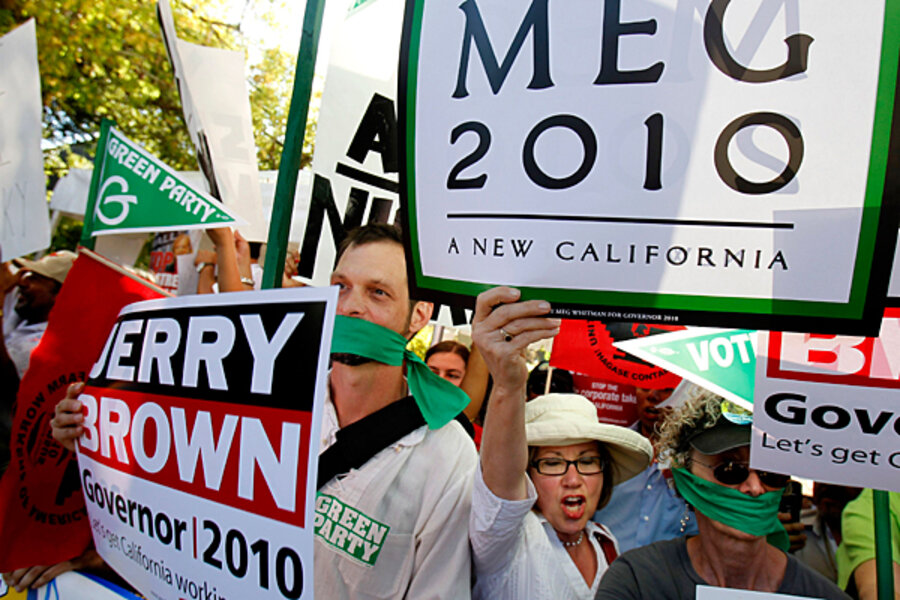In California midterm election's tight races, voter turnout is key
Loading...
| Sherman Oaks, Calif.
Sitting down to chicken tacos, rice, and a three-candidate congressional debate in the high school cafeteria, 60-something Don Potter says his votes are decided and that most seniors are also locked in because they are scared.
“Seniors are energized for this election,” says Mr. Potter, a registered Republican and founder/editor of NewSeniors.com, a website written by and for those just turning 65. “We want to know what’s going to happen with health care, taxes going up, the freeze on social security for the second year in a row … what world we’ll give to our grandchildren.… We’re very concerned.”
But Potter says Democratic campaign workers are not coming after him because “they are focusing their energy on independents right now.”
Two tables away sat proof of that observation in the person of 50-something day trader Peter Vukovich, a registered independent who says he won’t make up his mind until two days before the election.
“Democrats and Republicans both are after my vote,” Mr. Vukovich says. “The tea partyers want my vote, too, as a protest vote.”
With polls showing California leaning narrowly Democratic in the two highest profile races, for governor and US Senate, the cliché that the election result “will depend on turnout” is even more poignant in California for this midterm election, analysts say. The testimonies offered by Potter and Vukovich are an indicator of how parties’ get-out-the-vote programs are expending their resources, bypassing efforts to move some voters from entrenched positions while appealing energetically to the undecided.
Turnout key for Democrats
In general, higher turnouts favor Democrats, who have a built-in advantage with 44.5 percent of registered California voters (compared with 30.8 percent who are registered Republicans and 20.2 percent who “decline to state”), but if their base doesn’t show on Election Day, that advantage is out the window.
Jessica Levinson, political reform director for the Center for Governmental Studies, says Democrats would be pleased if 60 percent of their base, and 55 percent of the electorate, turned out on Election Day, but her best estimate right now is for only a 41 percent overall turnout, well below the 59.2 percent that voted in 2008, a presidential election year.
“Both Republicans and Democrats are spending lots of money to get out the vote,” says Hal Dash, CEO of Cerrell & Associates, a Democratic strategy consulting firm. “Democratic constituencies usually are harder to motivate in non-presidential years,” he says.
Rob Stutzman, a senior campaign adviser for Republican Meg Whitman, who is running for governor, says Whitman staffers are mainly concerned with getting out the Republican vote.
Although the campaign has 90 field offices with paid professional staff and thousands of volunteers who call voters and craft their message to whoever answers the phone, “California is very hard to navigate because of its size,” Mr. Stutzman says. “We’re primarily focused on GOP turnout but also identifying who the independents are to make sure they know what our message is, too.”
The GOP camp, meanwhile, has been energized by an Oct. 17-18 internal poll taken by The Tarrance Group of Alexandria, Va., showing the race for governor at “a pure dead heat” with 46 percent of California voters voting for Whitman and 46 percent for Brown. This contrasts with an Oct. 15 Rasmussen Poll which put Brown ahead, 50 to 44 percent.
Sterling Clifford, a spokesman for Democratic candidate Jerry Brown, says the Tarrance Group poll is definitely an “outlier,” meaning it disagrees so completely with several other polls that it needs to be thrown out.
“Every independent poll for the past week shows us with a five point lead or higher,” says Mr. Clifford. On Thursday, the Public Policy Institute of California, a non-partisan think tank, released its own poll showing Mr. Brown leading Ms. Whitman by 8 points, 44 percent to 36 percent, with 16 percent undecided.
Poll as motivator
But analysts say Republicans are using the Tarrance Group poll as further evidence for their voters that the race is so close that every single vote is needed.
“This race will go down to the wire, and it’s important that California voters know the truth about how close this race is,” Chris Schrimpf, spokesman for the Republican Governors Association, which released the poll, said in a statement.
Stutzman says the Whitman campaign has spent a lot of money on “professional staff that know how to target and run ground operations.” Whitman has spent, at last count, $141 million of her own money on her campaign. Outgunned, the Brown forces have labor unions which are spending money on his behalf.
“I think the biggest question is whether the outsourcing of Brown’s get-out-the-vote campaign – both to labor and to the party – will have any effect,” says Thad Kousser, associate professor of political science at University of California, San Diego.
One key this year, say experts, is younger voters. Therefore the good news, say Mr. Dash and other analysts, is the presence of Prop. 19 – the initiative to legalize marijuana for recreational use – on the ballot.
As for actually making it to the polls on election day, Potter says absolutely nothing will stop most seniors. “This is the most vital election I’ve ever voted in,” he declares, saying he has voted in every election since 1960. “Many of my friends are voting absentee because they say, ‘Jeez, I could be out sick that day or it might be raining, so I want to make sure my vote counts.’ ”
Not so for Mandore Oviedo, a 40-something filmmaker. When asked what could keep her from getting out and voting, she answers, “An all-day job … something which I haven’t had in more than eight months.”





